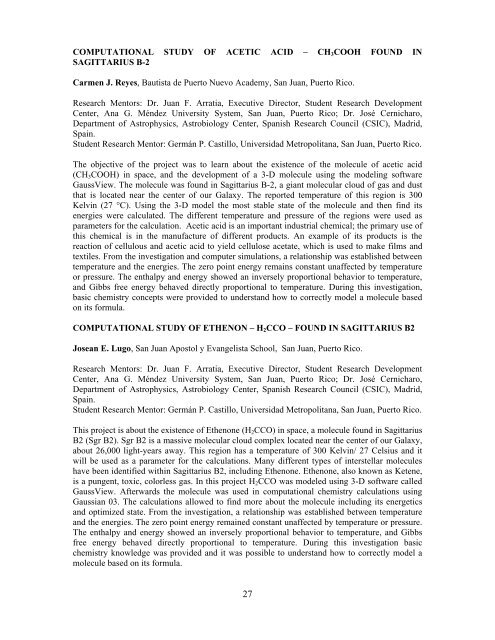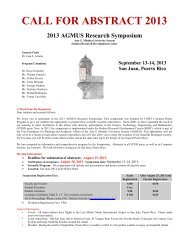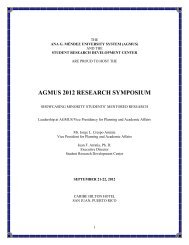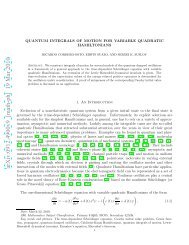WINTER 2008 PRE-COLLEGE RESEARCH SYMPOSIUM - Student ...
WINTER 2008 PRE-COLLEGE RESEARCH SYMPOSIUM - Student ...
WINTER 2008 PRE-COLLEGE RESEARCH SYMPOSIUM - Student ...
Create successful ePaper yourself
Turn your PDF publications into a flip-book with our unique Google optimized e-Paper software.
COMPUTATIONAL STUDY OF ACETIC ACID – CH 3 COOH FOUND IN<br />
SAGITTARIUS B-2<br />
Carmen J. Reyes, Bautista de Puerto Nuevo Academy, San Juan, Puerto Rico.<br />
Research Mentors: Dr. Juan F. Arratia, Executive Director, <strong>Student</strong> Research Development<br />
Center, Ana G. Méndez University System, San Juan, Puerto Rico; Dr. José Cernicharo,<br />
Department of Astrophysics, Astrobiology Center, Spanish Research Council (CSIC), Madrid,<br />
Spain.<br />
<strong>Student</strong> Research Mentor: Germán P. Castillo, Universidad Metropolitana, San Juan, Puerto Rico.<br />
The objective of the project was to learn about the existence of the molecule of acetic acid<br />
(CH 3 COOH) in space, and the development of a 3-D molecule using the modeling software<br />
GaussView. The molecule was found in Sagittarius B-2, a giant molecular cloud of gas and dust<br />
that is located near the center of our Galaxy. The reported temperature of this region is 300<br />
Kelvin (27 °C). Using the 3-D model the most stable state of the molecule and then find its<br />
energies were calculated. The different temperature and pressure of the regions were used as<br />
parameters for the calculation. Acetic acid is an important industrial chemical; the primary use of<br />
this chemical is in the manufacture of different products. An example of its products is the<br />
reaction of cellulous and acetic acid to yield cellulose acetate, which is used to make films and<br />
textiles. From the investigation and computer simulations, a relationship was established between<br />
temperature and the energies. The zero point energy remains constant unaffected by temperature<br />
or pressure. The enthalpy and energy showed an inversely proportional behavior to temperature,<br />
and Gibbs free energy behaved directly proportional to temperature. During this investigation,<br />
basic chemistry concepts were provided to understand how to correctly model a molecule based<br />
on its formula.<br />
COMPUTATIONAL STUDY OF ETHENON – H 2 CCO – FOUND IN SAGITTARIUS B2<br />
Josean E. Lugo, San Juan Apostol y Evangelista School, San Juan, Puerto Rico.<br />
Research Mentors: Dr. Juan F. Arratia, Executive Director, <strong>Student</strong> Research Development<br />
Center, Ana G. Méndez University System, San Juan, Puerto Rico; Dr. José Cernicharo,<br />
Department of Astrophysics, Astrobiology Center, Spanish Research Council (CSIC), Madrid,<br />
Spain.<br />
<strong>Student</strong> Research Mentor: Germán P. Castillo, Universidad Metropolitana, San Juan, Puerto Rico.<br />
This project is about the existence of Ethenone (H 2 CCO) in space, a molecule found in Sagittarius<br />
B2 (Sgr B2). Sgr B2 is a massive molecular cloud complex located near the center of our Galaxy,<br />
about 26,000 light-years away. This region has a temperature of 300 Kelvin/ 27 Celsius and it<br />
will be used as a parameter for the calculations. Many different types of interstellar molecules<br />
have been identified within Sagittarius B2, including Ethenone. Ethenone, also known as Ketene,<br />
is a pungent, toxic, colorless gas. In this project H 2 CCO was modeled using 3-D software called<br />
GaussView. Afterwards the molecule was used in computational chemistry calculations using<br />
Gaussian 03. The calculations allowed to find more about the molecule including its energetics<br />
and optimized state. From the investigation, a relationship was established between temperature<br />
and the energies. The zero point energy remained constant unaffected by temperature or pressure.<br />
The enthalpy and energy showed an inversely proportional behavior to temperature, and Gibbs<br />
free energy behaved directly proportional to temperature. During this investigation basic<br />
chemistry knowledge was provided and it was possible to understand how to correctly model a<br />
molecule based on its formula.<br />
27








